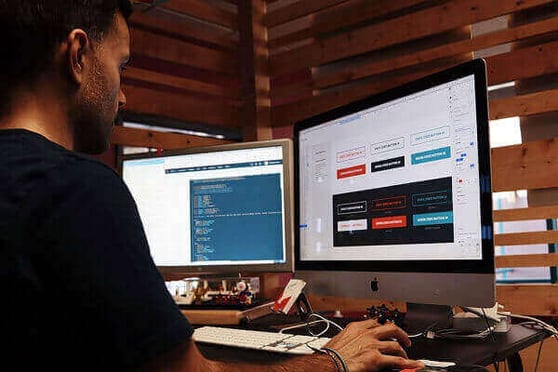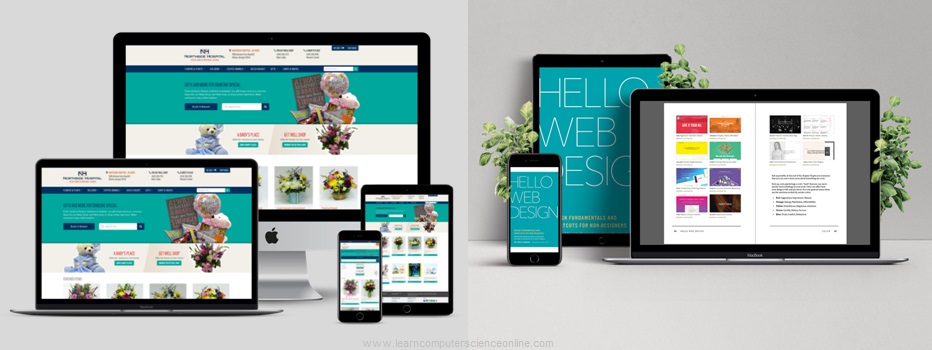Discovering the Numerous Kinds Of Website Design and Their Distinct Advantages
The landscape of Web style encompasses a selection of styles, each offering distinctive benefits that deal with various individual demands. Level and minimal layouts stress clarity, while receptive and material designs improve versatility throughout devices. Typography-driven and illustratory approaches intend to increase involvement and emotional vibration. Understanding these varied types can significantly affect customer experience and brand name understanding. What lies under the surface area of these design choices?
Minimal Web Style

Minimalist Web layout usually integrates a restricted shade scheme and uncomplicated typography, which not only improves looks however also reinforces brand name identity. The decreased complexity can cause quicker filling times, even more enhancing user complete satisfaction. In addition, by reducing aesthetic mess, individuals can engage with material better, resulting in boosted comprehension and retention. Generally, minimalist website design cultivates a smooth individual experience, making it a popular selection for brands aiming to convey clearness and professionalism and trust in their on the internet existence.
Responsive Website Design
Receptive Web layout has actually become vital in today's digital landscape, guaranteeing mobile compatibility for individuals throughout various tools. This approach greatly improves individual experience by giving smooth navigating and access, no matter of screen size. As even more people access the Web on tablet computers and mobile phones, the importance of receptive layout remains to expand.

Mobile Compatibility Significance
As mobile phone use remains to climb, making certain sites work with numerous display sizes has come to be crucial for efficient communication and engagement. Mobile compatibility, usually accomplished with responsive Web style, enables web sites to adjust flawlessly to mobile phones, tablet computers, and other tools. This adaptability not only reaches a broader target market however also boosts brand integrity. A web site that works well on mobile phones reflects professionalism and trust and interest to user demands. Furthermore, internet search engine prioritize mobile-friendly sites in their positions, making compatibility a crucial element for on the internet exposure. By purchasing mobile compatibility, businesses can enhance their electronic presence and deal with the expanding variety of users that access info on the move. As a result, prioritizing mobile-responsive style is important in today's electronic landscape.
Improved Individual Experience

Flat Layout
Level style is a minimal approach to Web style that highlights simplicity and quality. By getting rid of three-dimensional elements such as textures, gradients, and shadows, level design creates a visually attractive interface that focuses on material and capability. This style promotes an instinctive navigating experience, as users can promptly recognize key features and actions without distraction.
Among the main advantages of flat style is its responsiveness throughout different gadgets and display dimensions. Its tidy lines and straightforward formats adapt flawlessly, ensuring a consistent experience for users on mobile, tablet, or desktop computer systems. Furthermore, flat style usually integrates bold colors and typography, boosting aesthetic impact and brand acknowledgment.
The simpleness intrinsic in flat layout leads to much faster packing times, which contributes favorably to user fulfillment. In general, flat style remains a prominent selection for contemporary Web growth, lining visit the site up with modern aesthetic choices while delivering superb functionality
Material Layout
Material Design stands for a style language developed by Google that concentrates on producing a intuitive and natural user experience across electronic systems. This method highlights the usage of grid-based designs, receptive animations, and depth results such as illumination and shadows, which assist to develop a sense of hierarchy and spatial connections. By resembling the real world, Product Design enables customers to interact with electronic user interfaces in a much more engaging and natural way.
Among the key benefits of Material Style is its flexibility throughout various devices and display dimensions, guaranteeing a constant experience for individuals. In addition, it promotes a clear aesthetic language that enhances usability, making it less complicated for users to browse complicated applications. The incorporation of lively shades and bold typography likewise plays an essential role in drawing focus to vital components, thereby boosting total user involvement - branding. Product Style has actually ended up being a prominent selection amongst programmers looking for to develop practical and visually enticing internet sites.
Typography-Driven Layout
Typography-Driven Style concentrates on our website the tactical use kind to enhance the functional and visual elements of a web site. This style method focuses on typefaces, font dimensions, spacing, and power structure to produce aesthetic rate of interest and guide individual experience. By very carefully selecting typography, developers can communicate brand identification and stimulate emotions, making the web content extra interesting and obtainable.
Reliable typography boosts readability and functionality, guaranteeing that users can conveniently soak up and navigate the site details. The ideal mix of type can additionally establish a clear aesthetic hierarchy, permitting users to promptly identify key messages and contacts us to activity.
A typography-driven approach can be adapted to different gadgets, making certain consistency across systems. This adaptability is important in today's multi-device landscape, where individual experience is vital. Inevitably, Typography-Driven Layout serves not only as an artistic option yet likewise as a practical aspect that significantly impacts an internet site's performance.
Illustratory Web Design
Illustratory website design employs visual storytelling methods that can substantially enhance user engagement. By integrating distinct pictures, web sites can develop a remarkable brand name identification that reverberates with their audience. This method not only mesmerizes visitors however also communicates messages in a visually compelling manner.
Aesthetic Narration Techniques
A wide variety of Web developers utilize visual storytelling techniques to develop immersive and interesting customer experiences. This strategy integrates typography, imagery, and his response format to narrate a tale that reverberates with individuals on an emotional level. By integrating engaging visuals, designers can efficiently share messages and evoke feelings, leading visitors through a brand's journey. Infographics, animations, and interactive components serve to enhance narratives, making intricate information a lot more obtainable and remarkable. Furthermore, visual storytelling can establish a natural brand name identity, as regular imagery and styles strengthen core values and messages. Eventually, this method not just astounds users yet likewise promotes a much deeper connection with the web content, urging expedition and retention. Via competent application, aesthetic narration changes basic Web experiences into significant and vibrant interactions.
Enhancing Individual Involvement
Efficient website design considerably enhances individual interaction by leveraging illustratory components that attract attention and foster interaction. Pictures can streamline complex concepts, making them a lot more remarkable and friendly for customers. They break the uniformity of text-heavy web pages, producing visual breaks that invite exploration. Additionally, unique pictures can stimulate emotions, motivating users to get in touch with the web content on a much deeper level. Interactive components, such as computer animations or hover impacts, can likewise boost involvement by welcoming users to take part proactively as opposed to passively consuming info. This approach not just maintains site visitors on the site longer but likewise raises the chance of return gos to. Eventually, reliable illustrative Web style changes the individual experience, making it extra impactful and pleasurable.
Branding With Picture
Visual components play a considerable duty fit a brand name's identity, and pictures are a powerful device in this regard. Illustratory Web style permits brand names to share their distinct personality and values through custom-made art work. This approach fosters a much deeper emotional connection with the audience, improving memorability and involvement. By integrating images, brand names can distinguish themselves in a congested marketplace, producing a distinct visual story that resonates with their target group. In addition, illustrations can make and simplify complex concepts web content much more available, successfully interacting messages in an appealing manner. Generally, branding with image not only enriches the customer experience however also strengthens brand name acknowledgment, making it a useful strategy for businesses aiming to establish a strong on the internet existence.
Regularly Asked Inquiries
Just how Do I Select the Right Website Design Kind for My Organization?
To pick the best website design kind for a company, one ought to evaluate objectives, target market, and market requirements. Assessing customer experience and functionality will certainly direct the choice process for suitable interaction and efficiency.
What Devices Are Finest for Producing Different Web Layout Designs?
Popular tools for creating diverse website design styles include Adobe XD, Figma, Lay Out, and WordPress. Each offers unique functions customized to various design needs, making it possible for designers to construct aesthetically attractive and practical internet sites efficiently.
Just How Much Does Specialist Web Layout Generally Price?
Expert Web layout generally costs between $2,000 and $10,000, depending upon complexity, attributes, and developer experience. Personalized services and continuous maintenance might raise expenditures, while layouts can supply even more affordable options for easier jobs.
Can I Integrate Several Web Style Enters Properly?
Yes, combining multiple Web design types can be effective. By integrating components from various styles, designers can develop unique, appealing customer experiences that accommodate varied audiences while improving performance and aesthetic charm.
Exactly How Do Design Fads Effect Customer Experience and Involvement?
Layout trends greatly influence individual experience and involvement by boosting aesthetic allure, enhancing navigating, and fostering psychological connections - branding. Remaining updated with fads enables developers to create instinctive interfaces that reverberate with users and motivate prolonged communications
Minimalist and level designs stress clearness, while receptive and material layouts enhance adaptability across gadgets. It might seem counterproductive, minimalist Web style stresses simplicity to improve customer experience. Responsive Web style plays a vital role in improving user experience by making certain that a website adapts flawlessly to various screen dimensions and gadgets. Level layout is a minimalist method to Web layout that stresses simplicity and clarity. Product Design represents a style language created by Google that focuses on creating a cohesive and user-friendly user experience across digital systems.